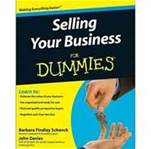
excerpt from the book Sunbelt wrote called “Selling a Business for Dummies”
Telling Your Business Story – Succinctly!
A buyer considering your business has plenty of alternatives. Though many aspects of a business sale are flexible, the window of opportunity you have to grab a buyer’s attention is not.
Quickly, you need to announce your offering, convey what your business is, and tell how well it performs financially and operationally. After you have the buyer’s attention, you need to be ready to deliver the fuller story of your business in a way that carries the initial interest to the next phase of the purchase decision.
Design an attention getting snapshot of your business and offering as well as create a compelling message to present the fuller picture. You will need to describe how your business works – how it does what it does, whom it serves and how it has succeeded and will continue to succeed in its marketplace.
 Strategizing Your Storytelling: Where to Invest Your Energy
Strategizing Your Storytelling: Where to Invest Your Energy
Business owners need to be able to make a powerful business introduction when a prospective buyer appears. Focus on the strengths. If you have a financially healthy business then the financial health will be the primary strength your buyer focuses on. Buyers will want to know how your business runs and especially if you are the only key operational player, how it can be easily transferred to a new owner. Spending time creating an operation manual will show the buyer how your shoes can be filled.
Briefly Introducing Your Business
You only have a few seconds to grab a buyer’s attention and convey what your business is and why it is worth further consideration. Amazingly many business owners are left tongue-tied when it comes time to describe their businesses. You can stumble through an explanation but a buyer –especially a buyer who is looking at a long list of business offerings – wants the facts in a quick, easy-to-grasp statement. To give your sale offering a second thought a buyer needs to know the basics, the simple who, what, where, when, why and how.
Quick introductions usually take place one of two ways:
- One-minute verbal introduction that is presented when telling prospects about your business. If you use a business broker, your broker presents this on your behalf.
- Written advertisement, which is a condensed version of your verbal introduction, is usually in the form of an online posting or print ad that prompts prospective buyers to request more information.
Introducing Your Business in 60 Seconds or Less
You need a quick inspiring introduction of your sale offering that you or your broker can deliver in 60 seconds or less, which is about how long a prospective buyer will take to decide whether they want more information. Consider these points when developing your elevator pitch.
- Your business description: Explain what your business does in away that leaves the buyer thinking; “Now this sounds interesting…”
- Your product or service: What does your business sell or provide.
- Your customer and market: Describe the location and nature of your market and the kind of customers you serve.
- Your business’s edge over the competition: How is your business unique and successful? Mention things like location, staff, systems or processes, marketing approach or special licenses, permits, relationships or contracts.
- Why you are selling: If possible, combine the reason for your desired exit with a positive point about why your timing is right for the buyer.
- Positive business trends: Provide a statement that gives a snapshot view of gross sales and financial trends.
- Your asking price: State how much you are asking for the business simply and directly.
After you figure out what to say for each point, combine your statements to create a short script that you can deliver in person or in writing.
Shrinking your 60 second Intro to a Short Advertisement
After you get your business introduction down, the next step is to shrink it to a short ad for placement online or in a printed publication. Buyers do not like to work to obtain information. They will either see what they are looking for as they scan your ad or they will move right past to the next ad.
EXAMPLE: Plumbing and heating business serving commercial and residential accounts for over 40 years. Sales $3.4Million. Asking price $1,250,000.
Give enough information for the buyer to decide if your business sounds attractive and like what they are looking for. Tell enough about the nature and price to allow buyers to pre-qualify themselves. According to Sunbelt Business Brokers, approximately 90% of initial buyer inquiries for businesses are responses to Internet business-for-sale listings. Nine times out of ten, you will introduce yourself online and many of those listings give you limited space to make a first impression.
Updating and Summarizing Your Business Plan
After you catch a buyer’s eye, you need to be ready to show how your business works. Do not be put off by the term business plan. For a small business, you may be looking at nothing more than a few pages that summarize your company, your business environment and your operations and finances, along with an action plan that details how your business intends to meet its goals and objectives. Business plans can run up to 100 pages long, this is not the plan you will share with your buyer. Highlight areas where your business is very strong and if it faces challenges, address the time, energy, and investment to overcome those challenges.
Highlighting Business Strengths
Where your business is strong, highlight your capabilities in your business plan, and then refer prospective buyers to more information such as:
- Location: If your location is a selling point, assemble information that presents the business, recreation, and lifestyle of the surroundings.
- Processes: If you have production processes that is a strong suit to the business, detail how you do what you do to prove to the buyer that your strengths are ready for seamless transfer. Reference that an operations manual is available, if you have one. Include details of your productions processes and be ready to share during the due diligence process.
- Relationships, licenses, or competitive advantages: Describe how the competitive advantages will transfer with the business to add strength after your departure.
- Rising Sales: If your sales are on an upward curve then marketing is a strength of your business and a strong purchase motivation. Show how your business attracts and will continue to attract customers buy including a summary of your marketing plan.
Overcoming Weaknesses
Where your business needs to overcome weaknesses or address looming threats, do not cower. Hit the issue head-on with descriptions of ready to go turn around plans. Especially:
- Declining Sales: Show the proposed marketing plan that can be implemented to reverse the situation.
- Declining Market: Present a plan for how your business is prepared to tap into new markets by promoting new geographic areas, marketing to new target customers or using direct and online marketing approaches to reach beyond the confines of your current marketplace.
- Aggressive Competitors: Outline your plan for retaining and growing your customer base.
- Marketplace Struggles: Describe an action plan to update or adapt your offerings to match current interests and trends.
- Transferability Issues: If your business might have difficulty transferring clients or production processes from seller to buyer – be prepared to address the issue. Either offer a transition period during which you are willing to remain available to assist the new owner or by ongoing presence of key staff. You do not want to highlight the problem but state your transition plan.
Describe Your Business Model
You may call this your revenue stream or your method for doing business regardless, your business model is how your business makes money. Some small businesses make money simply and directly by predicting a product or providing a service and selling that product or service to customers. Other business models involve sales through distributors, online marketing, auctions, licensing arrangements, or other channels. Detail how sales and other streams of revenue are generated. Show what portion of sale revenue pays for cost-of-sales or cost-of-goods. Present a list of how much you charge for products or services and if you charge different prices for different customers. If you have a sale distribution or pricing strategy outline the conditions that affect it. Explain payment arrangements and if your customers pay with cash, credit, if you send invoices, if they pay a retainer fee or if they sign purchase agreements. Include details about price increases or policies. Emphasize any areas that have experienced strong growth. For instance, if internet sales have grown or certain market niches have performed well, show how your business can capitalize on these areas. It is important to also point out any untapped revenue-growth opportunities.
Update and Summarize Your Marketing Plan
A business cannot generate strong earnings without first generating strong sales. Marketing is the key to sales. Describing your marketing approach is an essential component of your business sale offering. If your business already has a marketing plan, you can either present that document during due diligence or share it after the sale is closed. At the least, you will want to have a summary to show the buyer. Whether your business has a large or small marketing program and budget, if your sales are strong, a summary of your marketing plan will serve as a welcome game plan for your buyer to adopt and follow. If your sales are declining, your summary may be the key that opens your buyer’s minds to new opportunities. Your summary should outline the market situation, description of customers, growth, opportunity, segments served by your business, your market position, unique benefits, brand image, product, pricing and promotion strategies, marketing literature samples, advertising calendar, marketing expenditures and budget.
Explain Your Operations
By putting your operation policies into writing, you will enhance the attractiveness of your business. If you have a team of employees be ready to present your buyer with your employment policies. If you produce a unique product or service, be ready to show how you do what you do in a step-by-step manner that the new owner can review and adopt as part of an easy business transition. If your business only has a few employees, or if your operations are straightforward, outlining your policies should not take long. Every business needs a document that outlines how the business is run, though not all businesses will need a full manual. By providing an operation manual, employee policy, or a simple binder to explain what a new owner will need to know, your business will appear well managed, more attractive, and less risky to a buyer.





